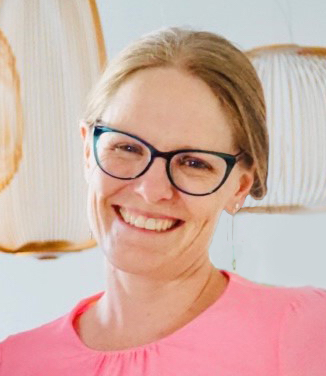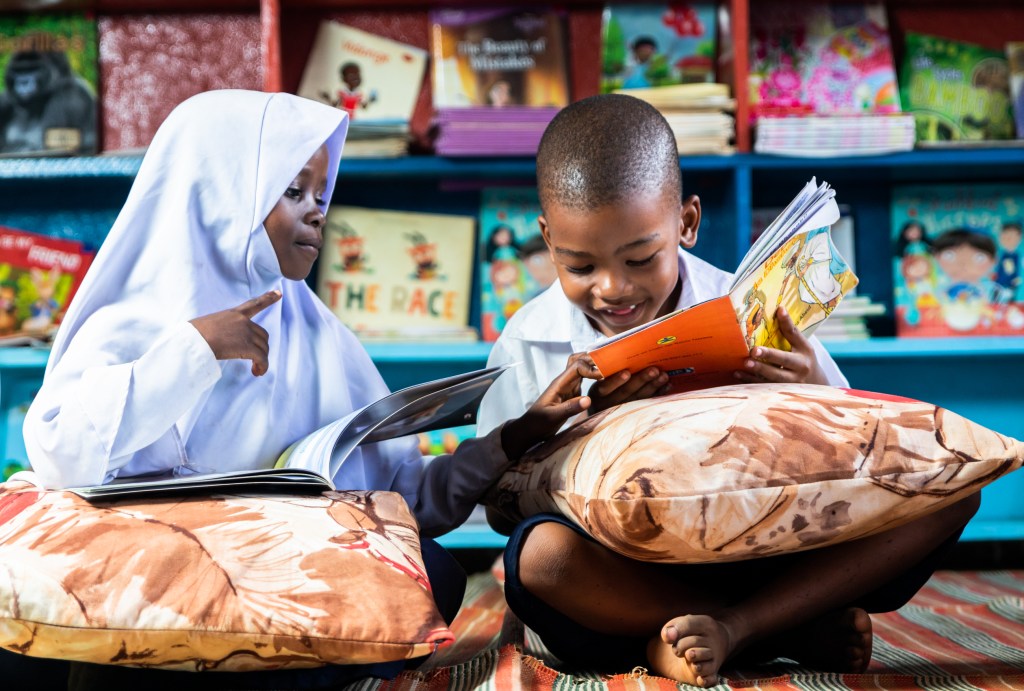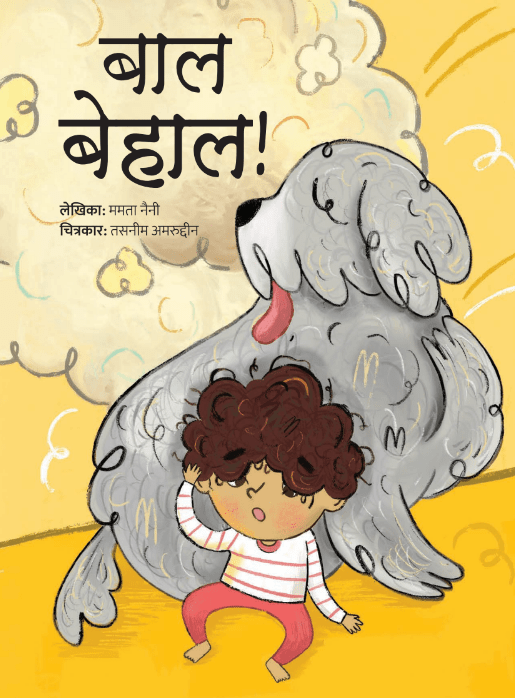In June 2022, a call went out for translators interested in working with children’s books to sign up for a paid mentorship with Room to Read, a nonprofit that creates and publishes books in 21 countries around the world. Here at World Kid Lit, our curiosity was piqued. In today’s interview, WKL co-editor Claire Storey asked Deborah Davis and Alisha N. Berger about Room to Read…


World Kid Lit: Hello Deborah and Alisha, welcome to World Kid Lit. Could you tell us a little about Room to Read? How did it all begin?
Alisha N. Berger: Room to Read began its work in 2000 in Nepal, where they began donating English books to local schools. Today, it’s a global organization aiming to transform the lives of millions of children through education, with the goal of creating a world free from illiteracy and gender inequality.
WKL: What impact has Room to Read had so far?
ANB: We have benefitted over 32 million children worldwide in our Literacy and Girls’ Education programs. Specifically, our Literacy program has distributed 36 million books, and published over 6100 titles in 53 languages across 21 countries. You can read more here: www.roomtoread.org/impact-and-reach/
WKL: Room to Read has so many hugely interesting projects. Today we’d like to focus specifically on your publishing activities. What role do they play?

ANB: Our publishing element is one of three parts of our Literacy program, which also includes reading curriculum development and instruction, and school libraries. These three elements combine to support the development of literacy skills and habit for children in government schools: what we like to call the science and magic of reading.
WKL: You work with local creators and often publish the books in-country. How do you find these creators?
ANB: We always publish the books in-country, with our fabulous country teams. Our local teams find creators in every which way: from advertisements online, in print, and on the radio; from the teachers and communities with whom we work; from local art schools and universities. Our latest strategy is challenging our country teams to develop books with local publishers, so that our books can reach both children in government schools and any other children served by organizations or people who buy books on the local market.
WKL: More recently you and Deborah have been working on a project in collaboration with translators and translation mentors. How did this come about?

English Language Translation Project Coordinator
Deborah Davis: Room to Read has created thousands of original children’s books over 22 years in roughly two dozen languages. That’s a fantastic resource—and potentially a truly global one. We had already done many translations. Books we’d created in one language, in one country, had been translated into other languages, both within that country, and in others. Some of those we’ve put on Literacy Cloud (LC), our free online children’s book library. For example, one LC title, Colours, written by Priyank Goawami, illustrated by Ajanta Guhathakurta, and originally written in Hindi, has been translated into five other languages: Marathi, Myanmar, Telegu, Kannada, and English.
To expand our books’ reach, though, they needed to be accessible via a relatively common language. So we decided to translate a number of the books into English, starting with the ones we published in 2021. Now any of our country offices can adapt a story that’s already translated into English into their local languages.

WKL: Which languages did this project cover, and why did you select these particular languages?
DD: The 13 languages covered in the English Language Translation Project (ELTP) were Bahasa Indonesia, Bengali, Filipino, Hindi, IsiZulu, Khmer, Lao, Nepali, Sinhala, Spanish, Swahili, Tamil, and Vietnamese. We selected these languages simply because they were the source languages for the 2021 books.
WKL: How did you select the translators you were working with, and did you face any challenges while you were recruiting them?
DD: The first translators I selected were our mentors for the project: Antonia Lloyd-Jones, Daniel Hahn, and Kareem James Abu-Zeid. I found them largely by networking and doing web searches: I contacted professional translator organizations, asked editors and publishers of translated children’s books for recommendations, and queried World Kid Lit. I also searched online to see who was writing and speaking about translating works for children—and that landed me squarely in the path of Danny Hahn. Of course, I wanted skilled and experienced translators with considerable mentoring experience—preferably in the field of children’s books. But I also wanted mentors who valued helping to build a skilled and confident pool of children’s book translators in each of the countries where Room to Read works. We knew we could find able translators in countries where English is a primary language; but we believed that there exist translators for whom English is not their first language, but who are capable of becoming strong source language-to-English translators.
Each of the three mentors has extensive networks within the international translation community. We planned a 90-minute webinar to inform attendees about the ELTP, and we all put out the word about it. I also contacted universities and Room to Read’s global staff, many of whom are experienced translators. More than 200 translators, editors, and publishers attended, and about 90 translators applied afterward for the mentorship program. Unfortunately, Kareem was only able to work with us for this first segment; so Antonia, Danny, and I selected the 30 participants. The three of us collaborated to design the mentorship itself, with input from Alisha and Room to Read’s regional directors.

Our main recruitment challenge was finding those in-country translators. And for all but six languages, we found them. To support the mentees whose language skills were not as strong, we either paired them with more experienced translators, provided additional editorial guidance, or both.
WKL: What has the project achieved?
DD: For starters, the translation of 94 children’s books! But also, I’m pleased to say, we’ve educated and supported and helped to develop a network of enthusiastic, skilled, translators—of children’s books specifically, but of any works, really, because while the books they translated were not lengthy, many of them were not easy! They contained metaphors and similes, poetry and lyrical language, double entendre, complex emotional arcs, humor and pathos, and more. We’re excited to have this remarkable pool of translators to call on for future Room to Read translation projects, and we’re also delighted that they’ll be available for non-RtR projects, as well as to support each other within the international children’s book translation community.

WKL: When will the books be published and do you have any favourites you can share with us?
DD: There’s no specific plan at this time to do print publications of the books. The 94 English translations are being made available to Room to Read’s nine country offices and affiliates. Those country offices and affiliates operate with considerable autonomy, so they can choose which of the translations they want to publish in other languages. We’re in the process of selecting our favorite ELTP books to upload to Literacy Cloud.
As for favorites…that’s a difficult question—like asking a parent to name their favorite child! But here are two that pop into my mind: From Viet Nam and translated by Nguyễn An Lý is Dreams of Green, written by Trịnh Hà Giang and illustrated by Trần Tiểu Sương, a lyrical, rhyming story about a boy who lives in outer space—because Earth is no longer habitable—and whose job is to collect floating trash. One day the boy finds a seed floating in space. He plants it in a homemade terrarium and nurtures it…and dreams of a return to a newly green, healthy Earth. It’s whimsical and hopeful, with just the right amount of suspense for young children, and An Lý did an extraordinary job creating a rhyming English version.

Hair Scare, written by Mamta Nainy illustrated by Tasneem Amiruddin
I also loved a delightful romp of a story from India titled Hair Scare, written by Mamta Nainy (herself a mentee in the mentorship program), illustrated by Tasneem Amiruddin, and translated by Nimmy Chacko. In Hair Scare, a child and their dog are desperate to evade the child’s mom, who is equally desperate to give at least one of them a haircut. She pursues them with scissors in her hand, and at one point gives chase on a skateboard. It’s hilarious, with a delightful twist at the end. (No children or animals are harmed in this story!)
WKL: Will you be running this sort of project again in the future?
DD: I hope so. While RtR will continue to translate books, there’s no concrete plan as of yet for another mentorship program. One thing I know is that while 2022 program included quite a lot of one-on-one mentoring, future mentorship programs will likely include more group instruction and peer support and critiquing, to continue to build up a network of children’s book translators, especially in the countries where Room to Read works.
WKL: The work Room to Read is doing is truly inspiring. If anyone reading would like to support Room to Read, what can we do?
DD: For starters, of course, Room to Read will happily accept your donations! But also, here’s a callout to translators of all the ELTP languages to contact Kris Duran (kris.duran@roomtoread.org) and express your interest in translating children’s books. Include your resume and a list of translated works. We’ll add you to our translator list, and you’ll hear about future professional development and translation opportunities. Even if we don’t currently work in your language, we may in the future, so please reach out!
